Bioscience Case Study: Managing a Staphylococcus Aureus Infection
VerifiedAdded on 2023/06/06
|7
|2014
|235
Case Study
AI Summary
This case study analyzes a wound infection scenario involving Staphylococcus aureus, detailing the physiological basis of the wound observations, potential sources of contamination (endogenous and exogenous), and the rationale behind the chosen antibiotics (ceftriaxone, cephalexin, and dicloxacillin). It further explains the wound healing process, including the inflammatory, proliferative, and maturation phases, emphasizing secondary intention healing due to the jagged nature of the wound. The study also highlights potential adverse reactions to dicloxacillin. Desklib provides access to similar solved assignments and past papers for students.
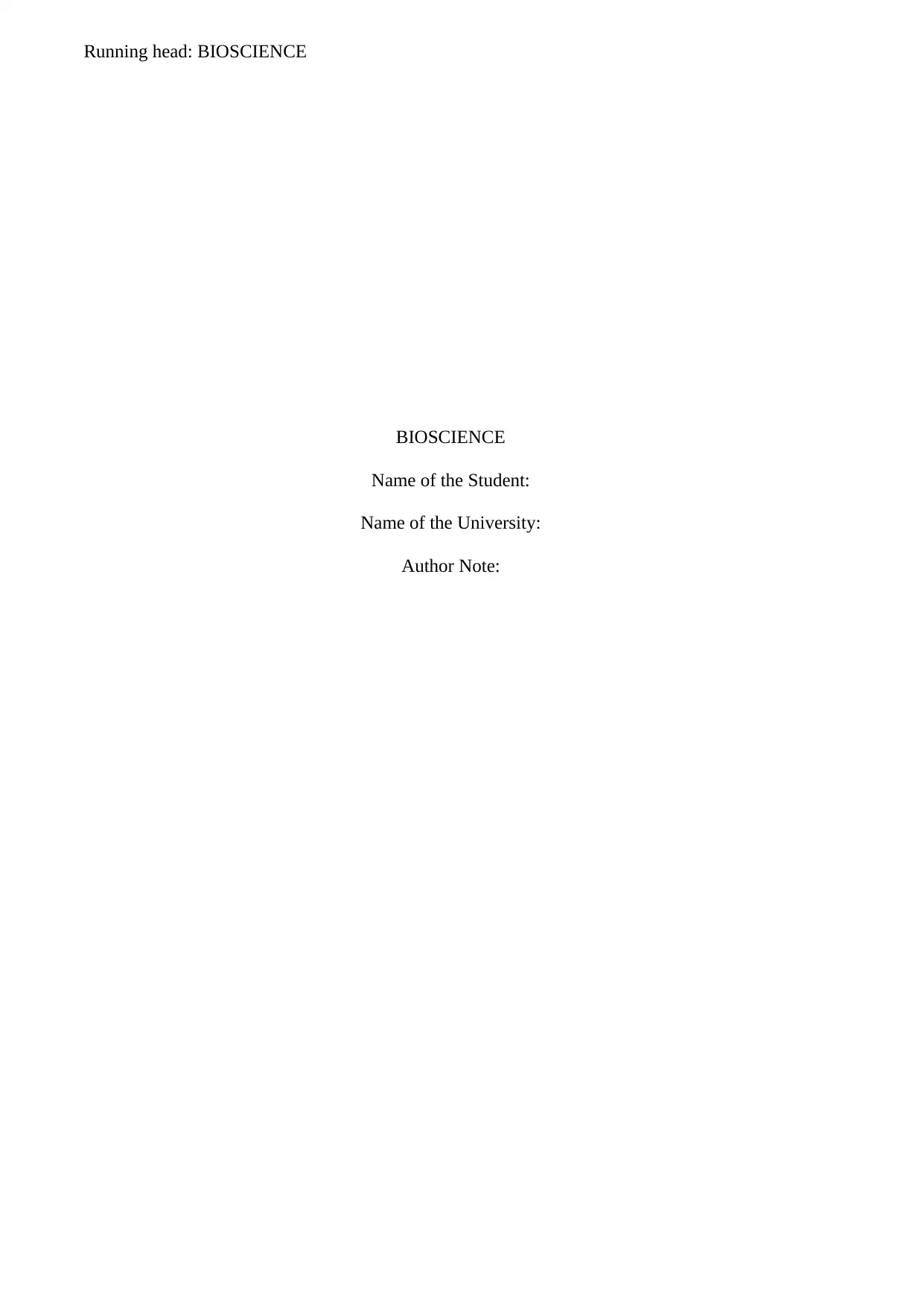
Running head: BIOSCIENCE
BIOSCIENCE
Name of the Student:
Name of the University:
Author Note:
BIOSCIENCE
Name of the Student:
Name of the University:
Author Note:
Paraphrase This Document
Need a fresh take? Get an instant paraphrase of this document with our AI Paraphraser
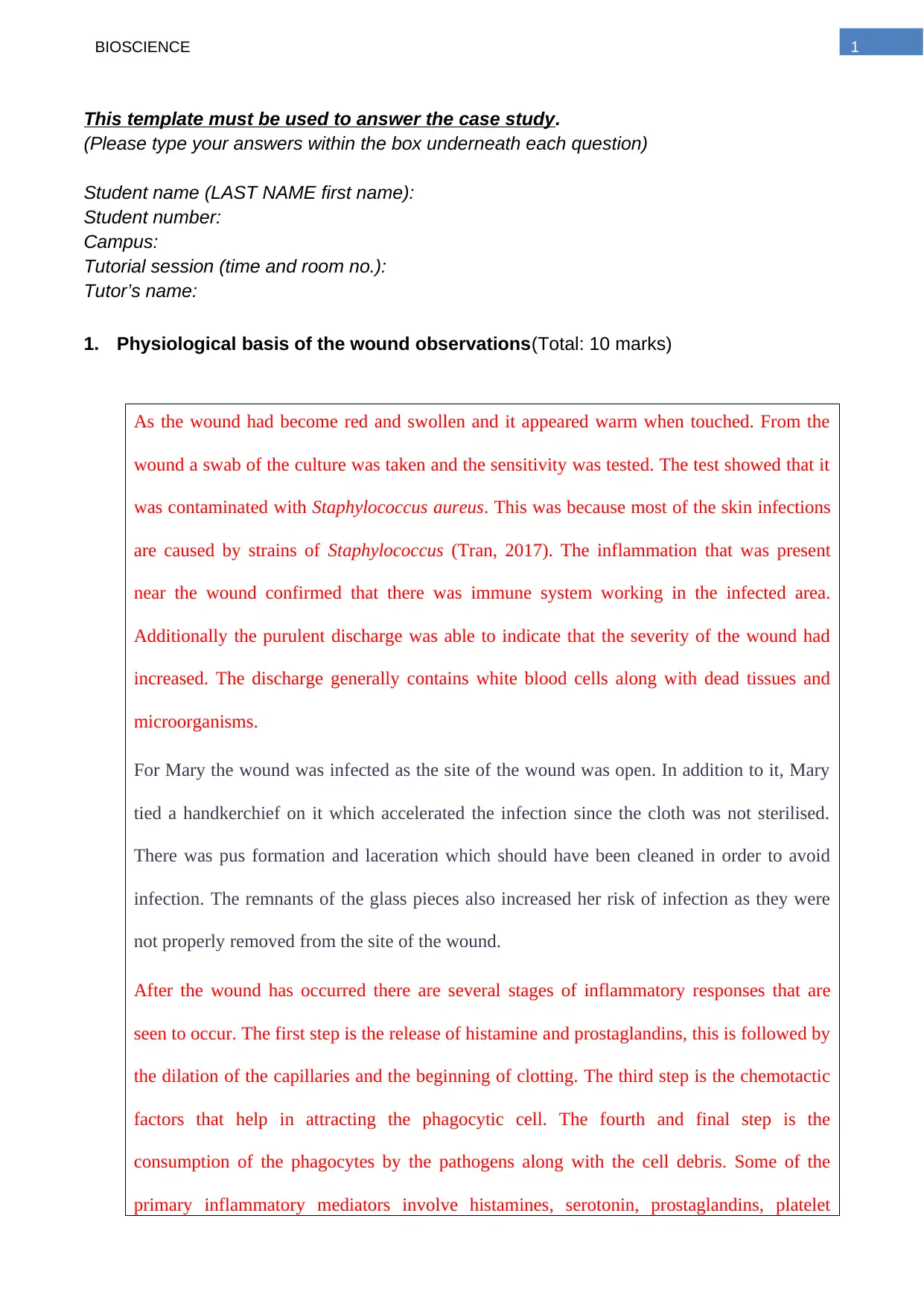
1BIOSCIENCE
This template must be used to answer the case study.
(Please type your answers within the box underneath each question)
Student name (LAST NAME first name):
Student number:
Campus:
Tutorial session (time and room no.):
Tutor’s name:
1. Physiological basis of the wound observations(Total: 10 marks)
As the wound had become red and swollen and it appeared warm when touched. From the
wound a swab of the culture was taken and the sensitivity was tested. The test showed that it
was contaminated with Staphylococcus aureus. This was because most of the skin infections
are caused by strains of Staphylococcus (Tran, 2017). The inflammation that was present
near the wound confirmed that there was immune system working in the infected area.
Additionally the purulent discharge was able to indicate that the severity of the wound had
increased. The discharge generally contains white blood cells along with dead tissues and
microorganisms.
For Mary the wound was infected as the site of the wound was open. In addition to it, Mary
tied a handkerchief on it which accelerated the infection since the cloth was not sterilised.
There was pus formation and laceration which should have been cleaned in order to avoid
infection. The remnants of the glass pieces also increased her risk of infection as they were
not properly removed from the site of the wound.
After the wound has occurred there are several stages of inflammatory responses that are
seen to occur. The first step is the release of histamine and prostaglandins, this is followed by
the dilation of the capillaries and the beginning of clotting. The third step is the chemotactic
factors that help in attracting the phagocytic cell. The fourth and final step is the
consumption of the phagocytes by the pathogens along with the cell debris. Some of the
primary inflammatory mediators involve histamines, serotonin, prostaglandins, platelet
This template must be used to answer the case study.
(Please type your answers within the box underneath each question)
Student name (LAST NAME first name):
Student number:
Campus:
Tutorial session (time and room no.):
Tutor’s name:
1. Physiological basis of the wound observations(Total: 10 marks)
As the wound had become red and swollen and it appeared warm when touched. From the
wound a swab of the culture was taken and the sensitivity was tested. The test showed that it
was contaminated with Staphylococcus aureus. This was because most of the skin infections
are caused by strains of Staphylococcus (Tran, 2017). The inflammation that was present
near the wound confirmed that there was immune system working in the infected area.
Additionally the purulent discharge was able to indicate that the severity of the wound had
increased. The discharge generally contains white blood cells along with dead tissues and
microorganisms.
For Mary the wound was infected as the site of the wound was open. In addition to it, Mary
tied a handkerchief on it which accelerated the infection since the cloth was not sterilised.
There was pus formation and laceration which should have been cleaned in order to avoid
infection. The remnants of the glass pieces also increased her risk of infection as they were
not properly removed from the site of the wound.
After the wound has occurred there are several stages of inflammatory responses that are
seen to occur. The first step is the release of histamine and prostaglandins, this is followed by
the dilation of the capillaries and the beginning of clotting. The third step is the chemotactic
factors that help in attracting the phagocytic cell. The fourth and final step is the
consumption of the phagocytes by the pathogens along with the cell debris. Some of the
primary inflammatory mediators involve histamines, serotonin, prostaglandins, platelet
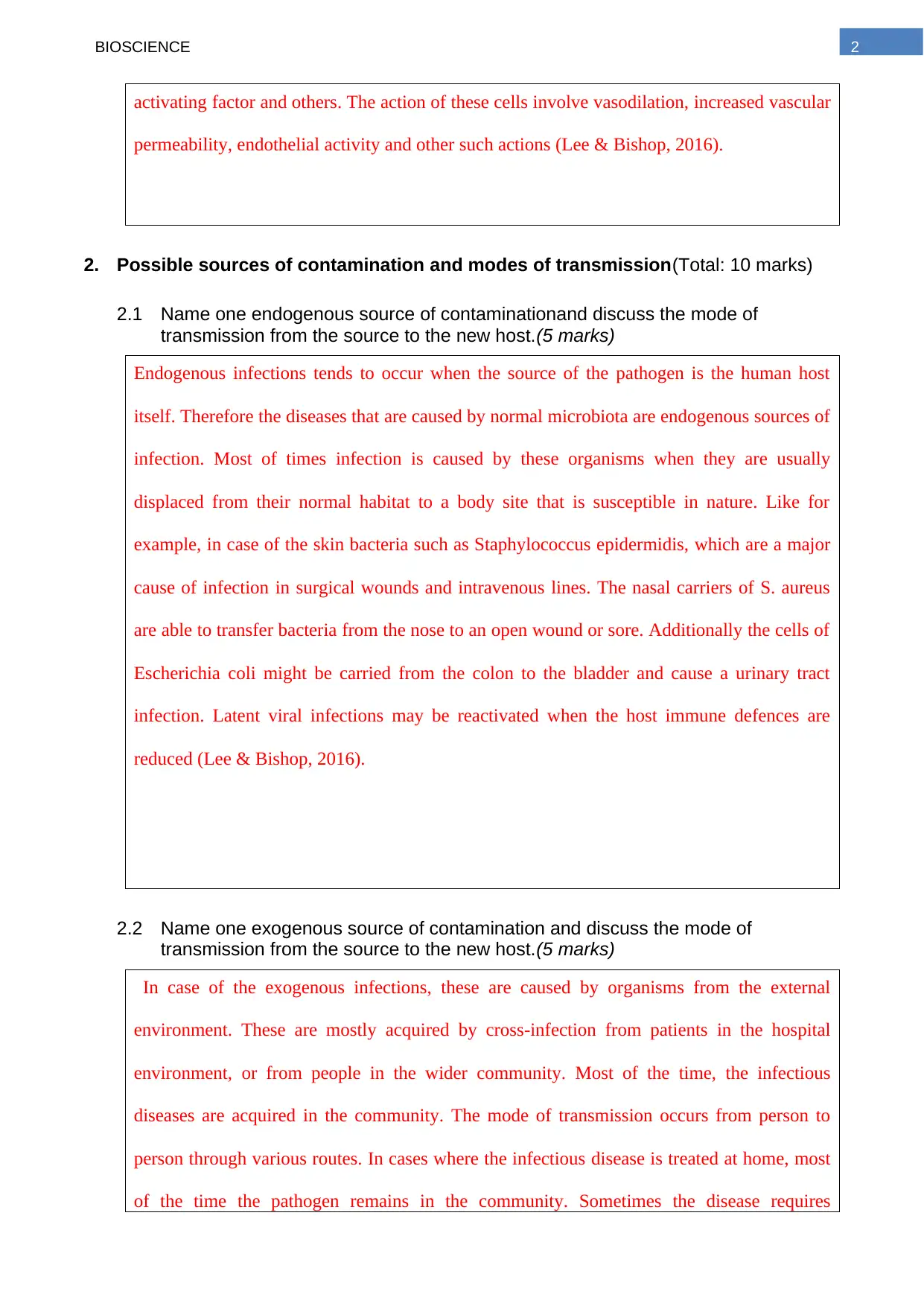
2BIOSCIENCE
activating factor and others. The action of these cells involve vasodilation, increased vascular
permeability, endothelial activity and other such actions (Lee & Bishop, 2016).
2. Possible sources of contamination and modes of transmission(Total: 10 marks)
2.1 Name one endogenous source of contaminationand discuss the mode of
transmission from the source to the new host.(5 marks)
Endogenous infections tends to occur when the source of the pathogen is the human host
itself. Therefore the diseases that are caused by normal microbiota are endogenous sources of
infection. Most of times infection is caused by these organisms when they are usually
displaced from their normal habitat to a body site that is susceptible in nature. Like for
example, in case of the skin bacteria such as Staphylococcus epidermidis, which are a major
cause of infection in surgical wounds and intravenous lines. The nasal carriers of S. aureus
are able to transfer bacteria from the nose to an open wound or sore. Additionally the cells of
Escherichia coli might be carried from the colon to the bladder and cause a urinary tract
infection. Latent viral infections may be reactivated when the host immune defences are
reduced (Lee & Bishop, 2016).
2.2 Name one exogenous source of contamination and discuss the mode of
transmission from the source to the new host.(5 marks)
In case of the exogenous infections, these are caused by organisms from the external
environment. These are mostly acquired by cross-infection from patients in the hospital
environment, or from people in the wider community. Most of the time, the infectious
diseases are acquired in the community. The mode of transmission occurs from person to
person through various routes. In cases where the infectious disease is treated at home, most
of the time the pathogen remains in the community. Sometimes the disease requires
activating factor and others. The action of these cells involve vasodilation, increased vascular
permeability, endothelial activity and other such actions (Lee & Bishop, 2016).
2. Possible sources of contamination and modes of transmission(Total: 10 marks)
2.1 Name one endogenous source of contaminationand discuss the mode of
transmission from the source to the new host.(5 marks)
Endogenous infections tends to occur when the source of the pathogen is the human host
itself. Therefore the diseases that are caused by normal microbiota are endogenous sources of
infection. Most of times infection is caused by these organisms when they are usually
displaced from their normal habitat to a body site that is susceptible in nature. Like for
example, in case of the skin bacteria such as Staphylococcus epidermidis, which are a major
cause of infection in surgical wounds and intravenous lines. The nasal carriers of S. aureus
are able to transfer bacteria from the nose to an open wound or sore. Additionally the cells of
Escherichia coli might be carried from the colon to the bladder and cause a urinary tract
infection. Latent viral infections may be reactivated when the host immune defences are
reduced (Lee & Bishop, 2016).
2.2 Name one exogenous source of contamination and discuss the mode of
transmission from the source to the new host.(5 marks)
In case of the exogenous infections, these are caused by organisms from the external
environment. These are mostly acquired by cross-infection from patients in the hospital
environment, or from people in the wider community. Most of the time, the infectious
diseases are acquired in the community. The mode of transmission occurs from person to
person through various routes. In cases where the infectious disease is treated at home, most
of the time the pathogen remains in the community. Sometimes the disease requires
⊘ This is a preview!⊘
Do you want full access?
Subscribe today to unlock all pages.

Trusted by 1+ million students worldwide
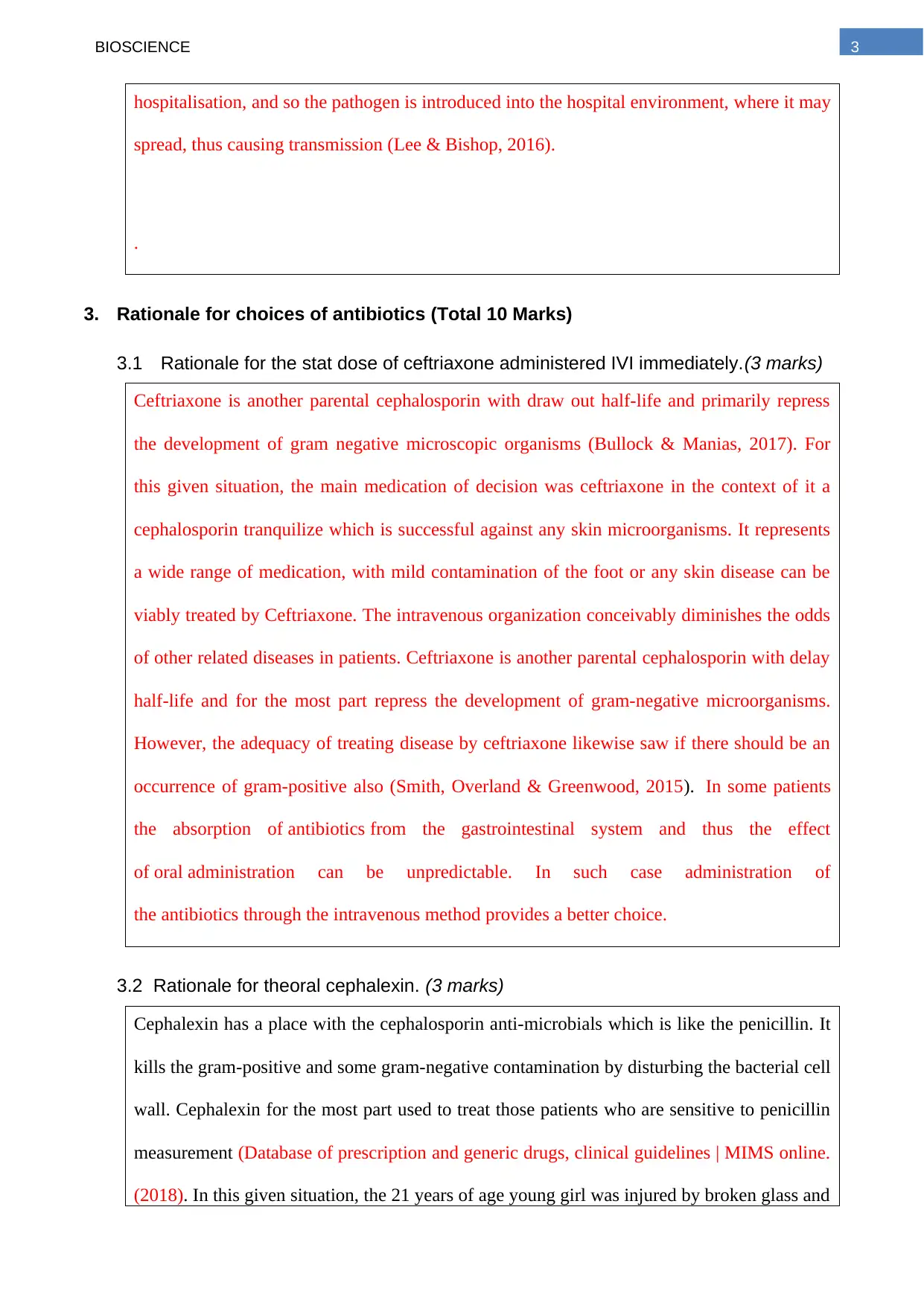
3BIOSCIENCE
hospitalisation, and so the pathogen is introduced into the hospital environment, where it may
spread, thus causing transmission (Lee & Bishop, 2016).
.
3. Rationale for choices of antibiotics (Total 10 Marks)
3.1 Rationale for the stat dose of ceftriaxone administered IVI immediately.(3 marks)
Ceftriaxone is another parental cephalosporin with draw out half-life and primarily repress
the development of gram negative microscopic organisms (Bullock & Manias, 2017). For
this given situation, the main medication of decision was ceftriaxone in the context of it a
cephalosporin tranquilize which is successful against any skin microorganisms. It represents
a wide range of medication, with mild contamination of the foot or any skin disease can be
viably treated by Ceftriaxone. The intravenous organization conceivably diminishes the odds
of other related diseases in patients. Ceftriaxone is another parental cephalosporin with delay
half-life and for the most part repress the development of gram-negative microorganisms.
However, the adequacy of treating disease by ceftriaxone likewise saw if there should be an
occurrence of gram-positive also (Smith, Overland & Greenwood, 2015). In some patients
the absorption of antibiotics from the gastrointestinal system and thus the effect
of oral administration can be unpredictable. In such case administration of
the antibiotics through the intravenous method provides a better choice.
3.2 Rationale for theoral cephalexin. (3 marks)
Cephalexin has a place with the cephalosporin anti-microbials which is like the penicillin. It
kills the gram-positive and some gram-negative contamination by disturbing the bacterial cell
wall. Cephalexin for the most part used to treat those patients who are sensitive to penicillin
measurement (Database of prescription and generic drugs, clinical guidelines | MIMS online.
(2018). In this given situation, the 21 years of age young girl was injured by broken glass and
hospitalisation, and so the pathogen is introduced into the hospital environment, where it may
spread, thus causing transmission (Lee & Bishop, 2016).
.
3. Rationale for choices of antibiotics (Total 10 Marks)
3.1 Rationale for the stat dose of ceftriaxone administered IVI immediately.(3 marks)
Ceftriaxone is another parental cephalosporin with draw out half-life and primarily repress
the development of gram negative microscopic organisms (Bullock & Manias, 2017). For
this given situation, the main medication of decision was ceftriaxone in the context of it a
cephalosporin tranquilize which is successful against any skin microorganisms. It represents
a wide range of medication, with mild contamination of the foot or any skin disease can be
viably treated by Ceftriaxone. The intravenous organization conceivably diminishes the odds
of other related diseases in patients. Ceftriaxone is another parental cephalosporin with delay
half-life and for the most part repress the development of gram-negative microorganisms.
However, the adequacy of treating disease by ceftriaxone likewise saw if there should be an
occurrence of gram-positive also (Smith, Overland & Greenwood, 2015). In some patients
the absorption of antibiotics from the gastrointestinal system and thus the effect
of oral administration can be unpredictable. In such case administration of
the antibiotics through the intravenous method provides a better choice.
3.2 Rationale for theoral cephalexin. (3 marks)
Cephalexin has a place with the cephalosporin anti-microbials which is like the penicillin. It
kills the gram-positive and some gram-negative contamination by disturbing the bacterial cell
wall. Cephalexin for the most part used to treat those patients who are sensitive to penicillin
measurement (Database of prescription and generic drugs, clinical guidelines | MIMS online.
(2018). In this given situation, the 21 years of age young girl was injured by broken glass and
Paraphrase This Document
Need a fresh take? Get an instant paraphrase of this document with our AI Paraphraser
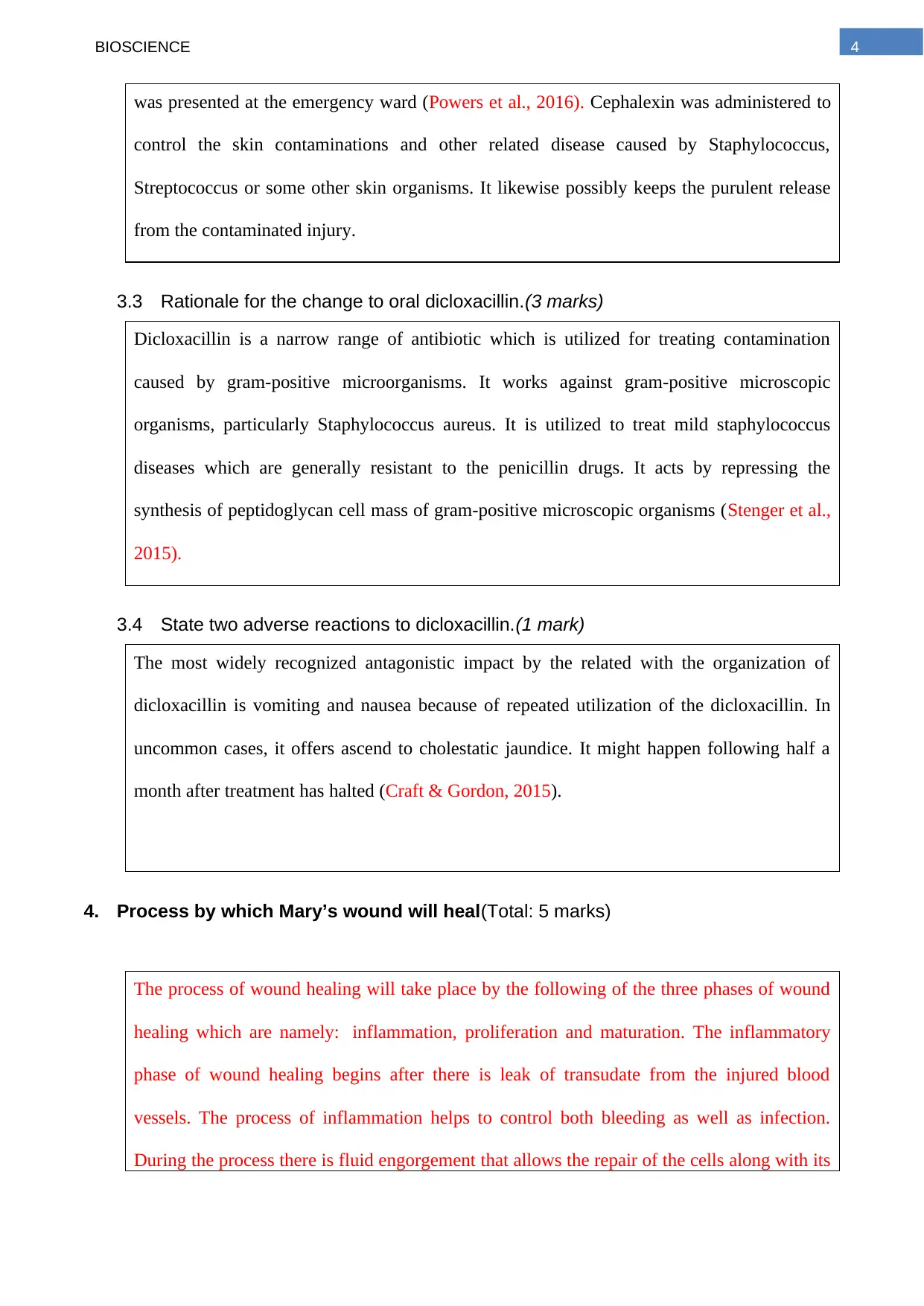
4BIOSCIENCE
was presented at the emergency ward (Powers et al., 2016). Cephalexin was administered to
control the skin contaminations and other related disease caused by Staphylococcus,
Streptococcus or some other skin organisms. It likewise possibly keeps the purulent release
from the contaminated injury.
3.3 Rationale for the change to oral dicloxacillin.(3 marks)
Dicloxacillin is a narrow range of antibiotic which is utilized for treating contamination
caused by gram-positive microorganisms. It works against gram-positive microscopic
organisms, particularly Staphylococcus aureus. It is utilized to treat mild staphylococcus
diseases which are generally resistant to the penicillin drugs. It acts by repressing the
synthesis of peptidoglycan cell mass of gram-positive microscopic organisms (Stenger et al.,
2015).
3.4 State two adverse reactions to dicloxacillin.(1 mark)
The most widely recognized antagonistic impact by the related with the organization of
dicloxacillin is vomiting and nausea because of repeated utilization of the dicloxacillin. In
uncommon cases, it offers ascend to cholestatic jaundice. It might happen following half a
month after treatment has halted (Craft & Gordon, 2015).
4. Process by which Mary’s wound will heal(Total: 5 marks)
The process of wound healing will take place by the following of the three phases of wound
healing which are namely: inflammation, proliferation and maturation. The inflammatory
phase of wound healing begins after there is leak of transudate from the injured blood
vessels. The process of inflammation helps to control both bleeding as well as infection.
During the process there is fluid engorgement that allows the repair of the cells along with its
was presented at the emergency ward (Powers et al., 2016). Cephalexin was administered to
control the skin contaminations and other related disease caused by Staphylococcus,
Streptococcus or some other skin organisms. It likewise possibly keeps the purulent release
from the contaminated injury.
3.3 Rationale for the change to oral dicloxacillin.(3 marks)
Dicloxacillin is a narrow range of antibiotic which is utilized for treating contamination
caused by gram-positive microorganisms. It works against gram-positive microscopic
organisms, particularly Staphylococcus aureus. It is utilized to treat mild staphylococcus
diseases which are generally resistant to the penicillin drugs. It acts by repressing the
synthesis of peptidoglycan cell mass of gram-positive microscopic organisms (Stenger et al.,
2015).
3.4 State two adverse reactions to dicloxacillin.(1 mark)
The most widely recognized antagonistic impact by the related with the organization of
dicloxacillin is vomiting and nausea because of repeated utilization of the dicloxacillin. In
uncommon cases, it offers ascend to cholestatic jaundice. It might happen following half a
month after treatment has halted (Craft & Gordon, 2015).
4. Process by which Mary’s wound will heal(Total: 5 marks)
The process of wound healing will take place by the following of the three phases of wound
healing which are namely: inflammation, proliferation and maturation. The inflammatory
phase of wound healing begins after there is leak of transudate from the injured blood
vessels. The process of inflammation helps to control both bleeding as well as infection.
During the process there is fluid engorgement that allows the repair of the cells along with its
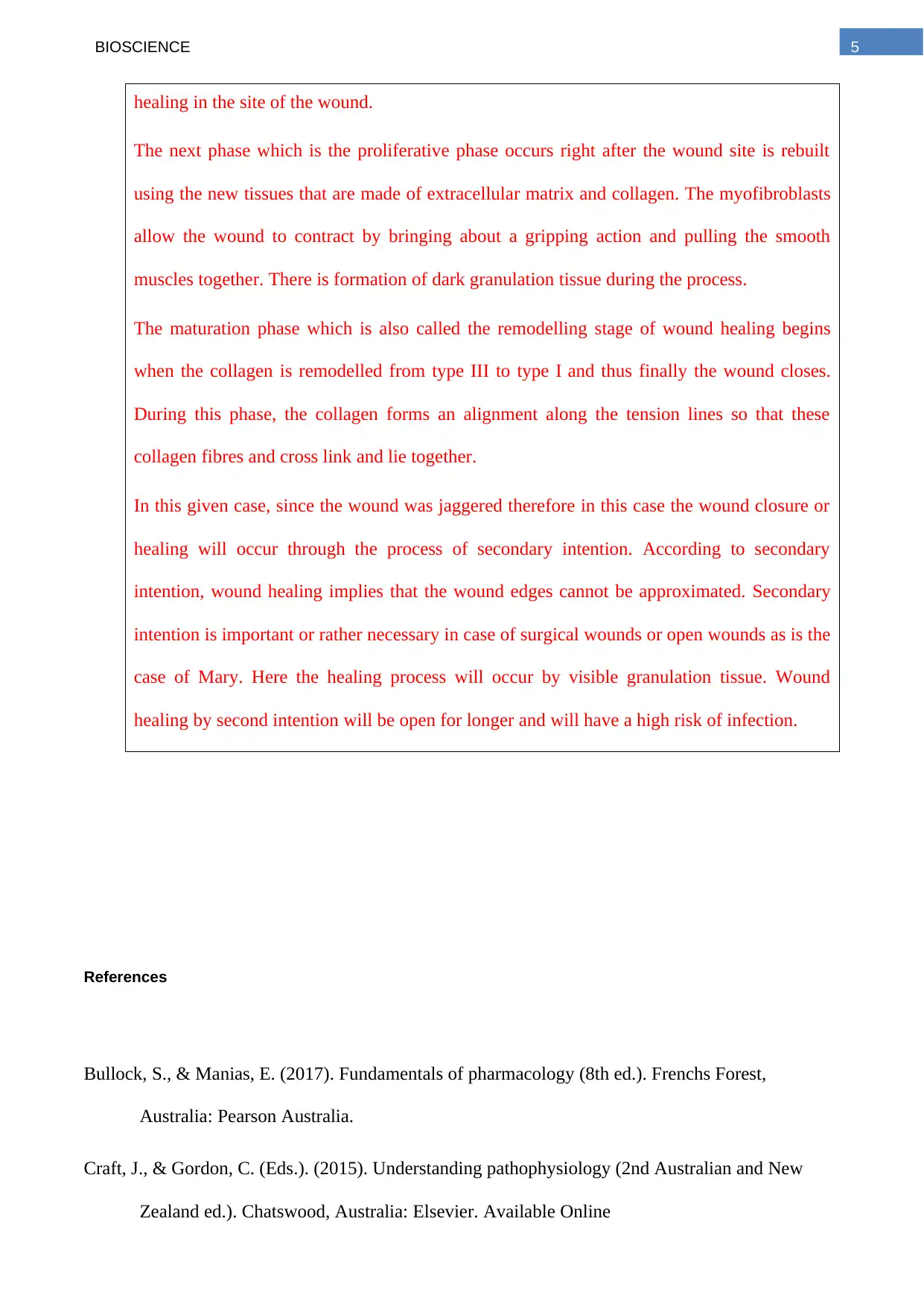
5BIOSCIENCE
healing in the site of the wound.
The next phase which is the proliferative phase occurs right after the wound site is rebuilt
using the new tissues that are made of extracellular matrix and collagen. The myofibroblasts
allow the wound to contract by bringing about a gripping action and pulling the smooth
muscles together. There is formation of dark granulation tissue during the process.
The maturation phase which is also called the remodelling stage of wound healing begins
when the collagen is remodelled from type III to type I and thus finally the wound closes.
During this phase, the collagen forms an alignment along the tension lines so that these
collagen fibres and cross link and lie together.
In this given case, since the wound was jaggered therefore in this case the wound closure or
healing will occur through the process of secondary intention. According to secondary
intention, wound healing implies that the wound edges cannot be approximated. Secondary
intention is important or rather necessary in case of surgical wounds or open wounds as is the
case of Mary. Here the healing process will occur by visible granulation tissue. Wound
healing by second intention will be open for longer and will have a high risk of infection.
References
Bullock, S., & Manias, E. (2017). Fundamentals of pharmacology (8th ed.). Frenchs Forest,
Australia: Pearson Australia.
Craft, J., & Gordon, C. (Eds.). (2015). Understanding pathophysiology (2nd Australian and New
Zealand ed.). Chatswood, Australia: Elsevier. Available Online
healing in the site of the wound.
The next phase which is the proliferative phase occurs right after the wound site is rebuilt
using the new tissues that are made of extracellular matrix and collagen. The myofibroblasts
allow the wound to contract by bringing about a gripping action and pulling the smooth
muscles together. There is formation of dark granulation tissue during the process.
The maturation phase which is also called the remodelling stage of wound healing begins
when the collagen is remodelled from type III to type I and thus finally the wound closes.
During this phase, the collagen forms an alignment along the tension lines so that these
collagen fibres and cross link and lie together.
In this given case, since the wound was jaggered therefore in this case the wound closure or
healing will occur through the process of secondary intention. According to secondary
intention, wound healing implies that the wound edges cannot be approximated. Secondary
intention is important or rather necessary in case of surgical wounds or open wounds as is the
case of Mary. Here the healing process will occur by visible granulation tissue. Wound
healing by second intention will be open for longer and will have a high risk of infection.
References
Bullock, S., & Manias, E. (2017). Fundamentals of pharmacology (8th ed.). Frenchs Forest,
Australia: Pearson Australia.
Craft, J., & Gordon, C. (Eds.). (2015). Understanding pathophysiology (2nd Australian and New
Zealand ed.). Chatswood, Australia: Elsevier. Available Online
⊘ This is a preview!⊘
Do you want full access?
Subscribe today to unlock all pages.

Trusted by 1+ million students worldwide
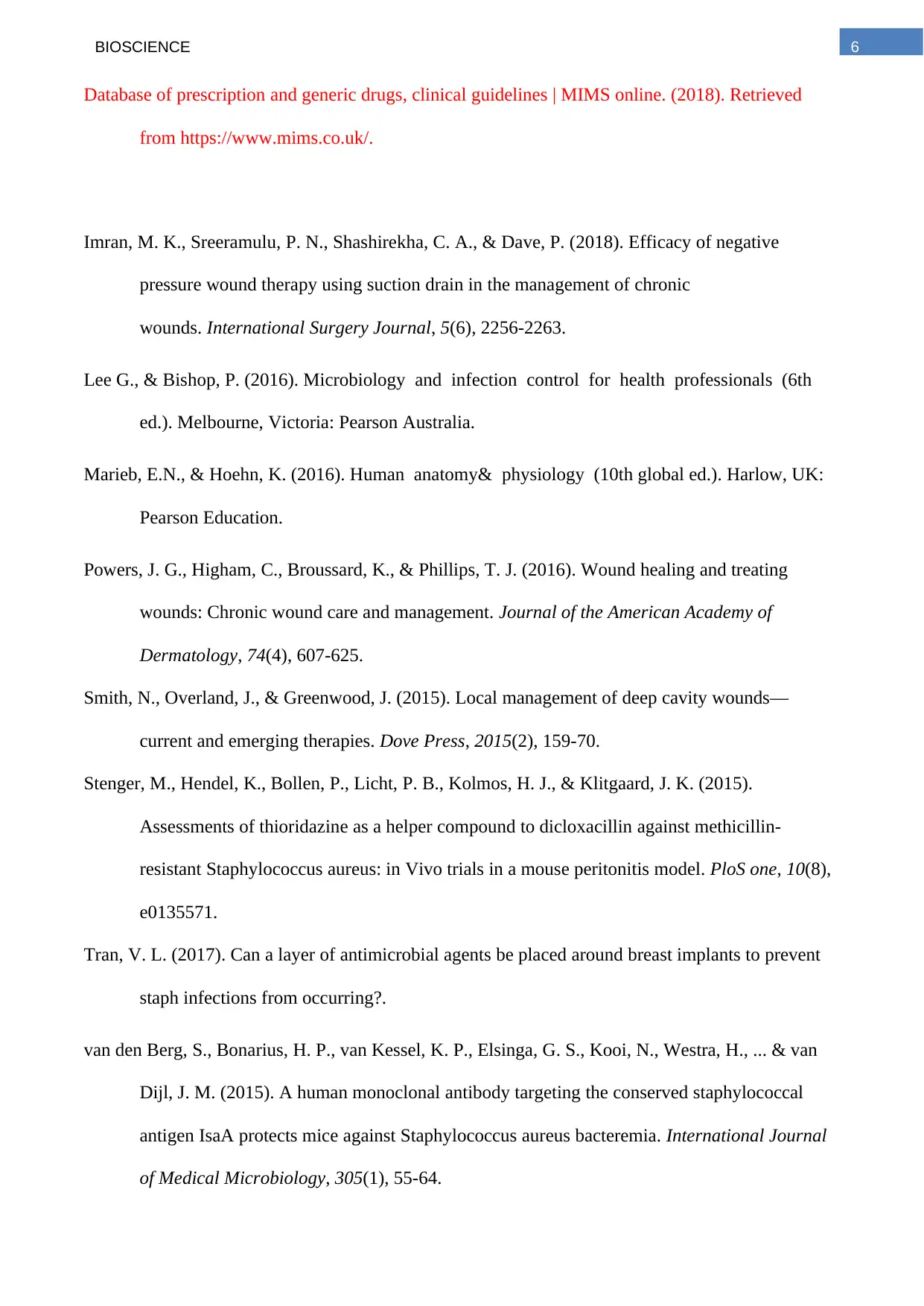
6BIOSCIENCE
Database of prescription and generic drugs, clinical guidelines | MIMS online. (2018). Retrieved
from https://www.mims.co.uk/.
Imran, M. K., Sreeramulu, P. N., Shashirekha, C. A., & Dave, P. (2018). Efficacy of negative
pressure wound therapy using suction drain in the management of chronic
wounds. International Surgery Journal, 5(6), 2256-2263.
Lee G., & Bishop, P. (2016). Microbiology and infection control for health professionals (6th
ed.). Melbourne, Victoria: Pearson Australia.
Marieb, E.N., & Hoehn, K. (2016). Human anatomy& physiology (10th global ed.). Harlow, UK:
Pearson Education.
Powers, J. G., Higham, C., Broussard, K., & Phillips, T. J. (2016). Wound healing and treating
wounds: Chronic wound care and management. Journal of the American Academy of
Dermatology, 74(4), 607-625.
Smith, N., Overland, J., & Greenwood, J. (2015). Local management of deep cavity wounds—
current and emerging therapies. Dove Press, 2015(2), 159-70.
Stenger, M., Hendel, K., Bollen, P., Licht, P. B., Kolmos, H. J., & Klitgaard, J. K. (2015).
Assessments of thioridazine as a helper compound to dicloxacillin against methicillin-
resistant Staphylococcus aureus: in Vivo trials in a mouse peritonitis model. PloS one, 10(8),
e0135571.
Tran, V. L. (2017). Can a layer of antimicrobial agents be placed around breast implants to prevent
staph infections from occurring?.
van den Berg, S., Bonarius, H. P., van Kessel, K. P., Elsinga, G. S., Kooi, N., Westra, H., ... & van
Dijl, J. M. (2015). A human monoclonal antibody targeting the conserved staphylococcal
antigen IsaA protects mice against Staphylococcus aureus bacteremia. International Journal
of Medical Microbiology, 305(1), 55-64.
Database of prescription and generic drugs, clinical guidelines | MIMS online. (2018). Retrieved
from https://www.mims.co.uk/.
Imran, M. K., Sreeramulu, P. N., Shashirekha, C. A., & Dave, P. (2018). Efficacy of negative
pressure wound therapy using suction drain in the management of chronic
wounds. International Surgery Journal, 5(6), 2256-2263.
Lee G., & Bishop, P. (2016). Microbiology and infection control for health professionals (6th
ed.). Melbourne, Victoria: Pearson Australia.
Marieb, E.N., & Hoehn, K. (2016). Human anatomy& physiology (10th global ed.). Harlow, UK:
Pearson Education.
Powers, J. G., Higham, C., Broussard, K., & Phillips, T. J. (2016). Wound healing and treating
wounds: Chronic wound care and management. Journal of the American Academy of
Dermatology, 74(4), 607-625.
Smith, N., Overland, J., & Greenwood, J. (2015). Local management of deep cavity wounds—
current and emerging therapies. Dove Press, 2015(2), 159-70.
Stenger, M., Hendel, K., Bollen, P., Licht, P. B., Kolmos, H. J., & Klitgaard, J. K. (2015).
Assessments of thioridazine as a helper compound to dicloxacillin against methicillin-
resistant Staphylococcus aureus: in Vivo trials in a mouse peritonitis model. PloS one, 10(8),
e0135571.
Tran, V. L. (2017). Can a layer of antimicrobial agents be placed around breast implants to prevent
staph infections from occurring?.
van den Berg, S., Bonarius, H. P., van Kessel, K. P., Elsinga, G. S., Kooi, N., Westra, H., ... & van
Dijl, J. M. (2015). A human monoclonal antibody targeting the conserved staphylococcal
antigen IsaA protects mice against Staphylococcus aureus bacteremia. International Journal
of Medical Microbiology, 305(1), 55-64.
1 out of 7
Related Documents
Your All-in-One AI-Powered Toolkit for Academic Success.
+13062052269
info@desklib.com
Available 24*7 on WhatsApp / Email
![[object Object]](/_next/static/media/star-bottom.7253800d.svg)
Unlock your academic potential
Copyright © 2020–2025 A2Z Services. All Rights Reserved. Developed and managed by ZUCOL.

